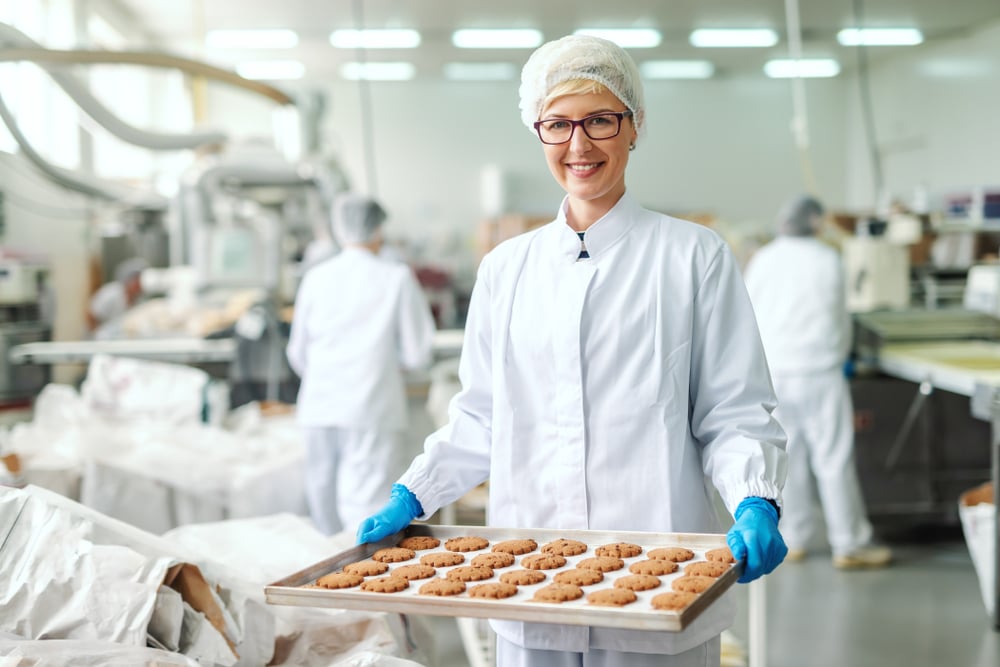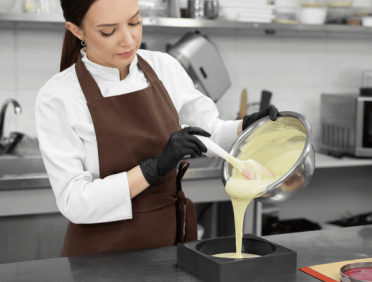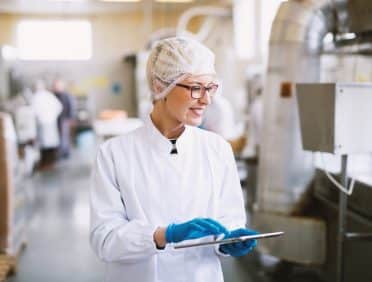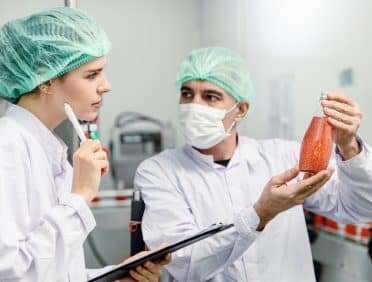Learn Q is committed to providing tailored, bespoke training for food hygiene safety guidelines. Learning about food hygiene is vital for all staff, and a modern training system helps to guarantee compliance.
Food Hygiene Safety Legislation
There are several important food hygiene safety legislations to think about in the UK.
The Food Safety Act 1990 provides an official framework for food legislation and creates offences regarding quality, safety and labelling. There is also the General Food Law Regulation (EC) 178/2003, which is an EU regulation translated into UK law. This guideline creates specific principles and requirements regarding food law.
Finally, there is the Food Safety and Hygiene Regulations 2013, which both re-enact and revoke some minor changes to the 2006 edition of the regulations, as well as specific provisions in the General Food Regulations.
Does Food Safety Legislation Apply to Me?
If you are a business that supplies food or drinks to your guests, then you have a legal obligation to comply with the provisions laid down by the legalisations.
All staff who work with food on a regular basis should receive proper and comprehensive training. They will need to safely handle food and be able to create and follow hygiene policies. Failure to comply with policies can result in fines and sanctions.
Food Safety Management Procedures
Any business which is going to serve food to customers needs to put into place and implement a food safety management solution which is readily compliant with regulations. The recommended format for this is the HACCP principles.
The Hazard Analysis and Critical Control Point (HACCP) Plan is a required part of health and safety for food. However, the way a business implements the principles can be proportionate to the size and nature of its operation – a small business does not need to overburden itself in pursuit of these regulations, for example.
The HACCP regulations cover the following principles:
A business must analyse and evaluate all of the potential food hazards. A food hazard is considered to be anything which might hurt the consumer.
Analysis
Once you have identified where the points in operation prone to hazards are, a proper analysis of the hazards is necessary to create solutions.
Critical
The next step of the process is to make sure that you identify which points are critical to the successful ensuring of food safety. The most critical issues are the ones which need immediate attention.
Control
The Control step of the HACCP principles is all about taking the time to identify and implement effective monitoring and control solutions at the critical points highlighted.
Furthermore, if the procedures are implemented and do not work, then it is necessary to take corrective actions. Businesses must identify and implement these actions.
Point
The final step in the HACCP principles is to make sure that the proper records are kept, which is evidence that the procedures you have implemented are working. You’ll need to make sure that you take a look at the procedures from time to time and review them or if the food operations change in a significant fashion.
Food Allergies
It is suggested that 2% of the population suffers from food allergies in the UK. Therefore, it is necessary to make sure that you provide food that is not only safe for customers to eat but is of suitable quality as described under the Food Safety Act 1990 and the General Food Law Regulation 178/2002.
The most common allergens in food are as follows:
Cereals which contain gluten – include wheat, oats, barley, and rye.
Seafood – specifically prawns, crabs, crayfish and lobster.
Eggs
Fish
Soybeans
Peanuts
Lactose/Milk
Nuts – walnuts, peanuts, almonds, cashews, pistachio, Brazil nuts, and hazelnuts.
Celery
Sesame
Mustard
Sulphur Dioxide – this can be added to dried fruit as a preservative. Accept anything above 10mg/kg or 10mg/L.
Lupin – lupin seeds and flour can be heard in types of bread, pasta and pastries.
Molluscs – whelks, squid, snails, mussels and oysters.
Businesses need to be aware of any of these allergens in the food that they prepare and communicate this information to customers.
From October 2021, businesses were required to provide allergen labelling information for any Prepackaged for Direct Sale (PPDS) products. Foods now need to have a label which contains a full list of ingredients, with the allergenic ingredients listed clearly and with emphasis.
Personal Hygiene
Personal hygiene standards should be enforced and clearly outlined to all staff who work with food or enter an environment where food is handled and stored. The following rules are core ideas in a personal hygiene code:
- Hair should be properly tucked away inside a cap or hat if long enough to hang loose.
- There should be no earrings, necklaces or chains worn in the environment where food is handled or stored.
- Clothing should have no outer pockets.
- All staff should wear neat, clean clothing.
- Staff should not wear rings or a wristwatch while preparing or handling food.
- Any wounds should be covered and properly bandaged.
- Nails should be kept clean and at a short length.
- Torn clothing should be repaired or replaced when possible.
- Clogs or safety shoes should be worn at all times. No open-toed shoes can be worn.
You can download our free personal hygiene checklist by clicking here.
Food Contact Materials
Food contact materials are materials which are meant to come in contact with food. You can have many different types of these materials, ranging from the obvious things like a glass or a fork to the machinery used in a food factory.
There are four basic steps to food safety. Let’s talk about each of them.
Cleaning – make sure that your hands, equipment and surfaces are cleaned before, sharing and after the cooking process.
Cooking – make sure that food is cooked through to kill any harmful bacteria.
Chilling – make sure that foods are all stored at the proper temperature to prevent the growth and development of harmful bacteria.
Cross-Contamination – ensure that the surfaces you prepare food on are cleaned to stop the spread of bacteria, which will result in cross-contamination.
Taking proper care to clean your kitchen area is important to ensure a good standard of hygiene and prevent the buildup of bacteria.
Take care to wash your hands with soap and warm water, and also make sure that you wash your hands before you prepare, handle or cook food that contains raw products – meat, eggs, and unwashed fruits and vegetables. Make sure to wash your hands after interacting with bins or disposal units too.
Clean all worktops, chopping boards and cooking utensils with warm water and soap to prevent the build-up and spreading of bacteria. This is particularly important if you’re going to handle raw meats or eggs. Where possible, use different kinds of equipment for each type of food.
Keeping Food Safe For Consumption
Keeping food safe for consumption is an important part of food hygiene and requires the implementation of a rigorous code to get it right.
Food Temperature and Reheating
Foods can not be kept at a temperature which might make them unsafe to eat. Foods need to be kept in temperature-controlled areas. Hot foods need to be at or above a minimum temperature of 63°C, and chilled foods need to be at or below a minimum temperature of 8°C
You must not keep foods at a temperature that might make them unsafe to eat. Foods which need temperature control for safety must be held either:
Serving Food
Food which is normally kept at or below temperatures of 8°C can be kept above that temperature for a period of four hours maximum.
Food that is served hot may be kept on display without temperature control of 63°C or above for a single span of two hours.
Bacteria and Food Poisoning
In the event that bacteria and food poisoning occurs, the selling of food must stop until the issue has been identified and resolved. All instances of food poisoning must be logged, recorded and stored for official purposes.
Storing Food Safely
Taking the time to store food safely is an important part of everyday operations. Food safety and storage regulations are designed to offer staff suitable training on what to do.
Covering and Storing Food
Regulations for covering and storing food are as follows:
Check that the temperature of all purchased chilled or frozen ready-to-eat foods is correct.
Check all products to make sure that they are within the date code and that the packaging is not damaged.
Don’t use the products after their “use by” date.
Make sure to store ready-to-eat products separately from any raw ingredients such as meat, poultry, eggs, and other similar things.
Make sure to store all items at the correct temperatures and rotate stock as necessary.
Follow any instructions by the manufacturer on the storage and preparation of foods.
Make sure to wash and dry your hands before handling ready-to-eat foods.
Pest Control
If pests are found on the property or evidence of pests is identified, the relevant authorities should be contacted and all steps taken to protect food from harm and further exposure to pests.
To download a .pdf of this blog, please click here












